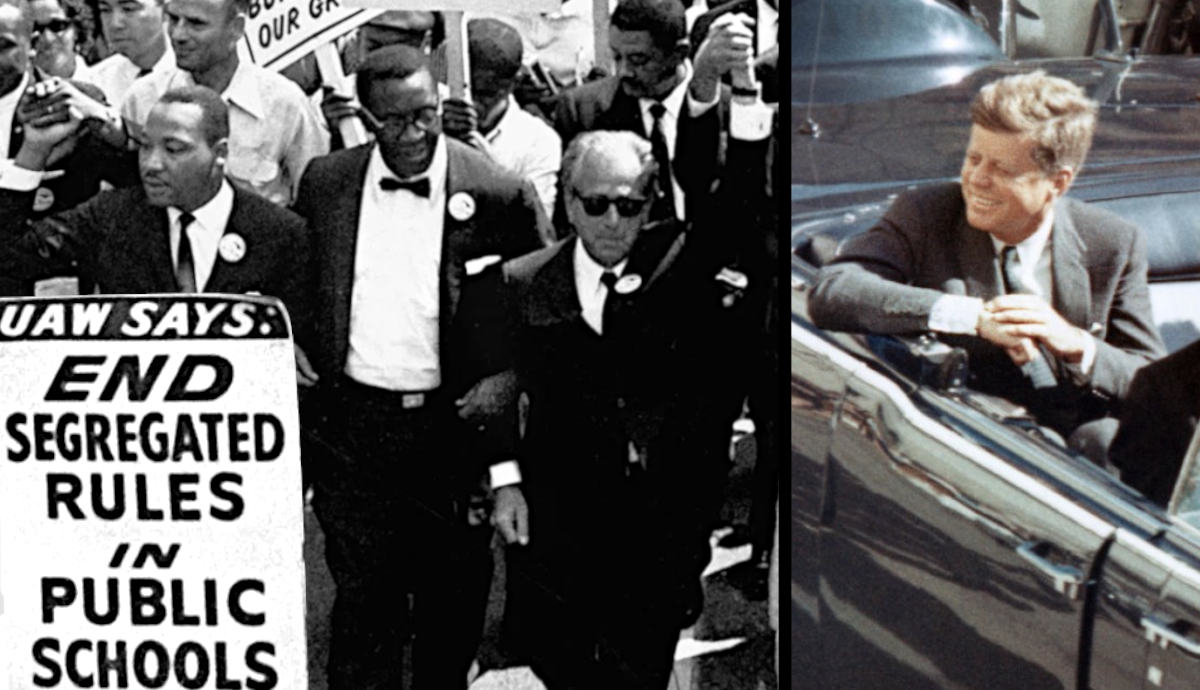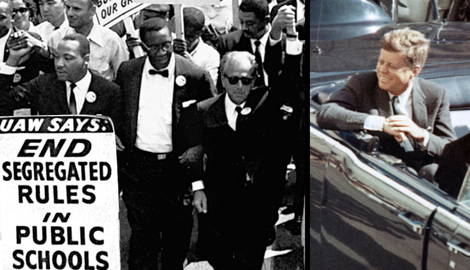
Widely regarded as an era of tumultuous change across political, economic, and social realms, the 1960s America was revolutionary, to say the least. In addition to the civil rights movement and the emergence of counterculture, the American public was confronted with widespread political disillusionment. This was largely compounded by the government’s questionable involvement in the Vietnam War, as well as its inability to manage socio-political unrest at home. This article discusses the seismic shifts in American society during the 1960s, highlighting how these changes have profoundly impacted the country.
The Prelude to 1960s

Having emerged from World War II victorious, in the United States the 1950s represented a decade of prosperity and growth. The post-WWII economic boom saw Americans ushering in an era characterized by minimal inflation, low unemployment rates, and high consumerism. Between 1945 and 1960, the United States’ gross national product saw unprecedented growth, increasing from $200 billion to a whopping $500 billion. Government spending was at an all-time high, with the construction of interstate highways and schools, as well as increased military spending on airplanes and new technologies. Brimming with optimism after a decade of hardship and uncertainty, the middle class began enjoying leisure activities such as shopping and going to the movies. Suburban living was also embraced by the middle class who flocked to newly built tract houses in New York, New Jersey, and Pennsylvania among other places.

While the 1950s appeared to be a promising era of prosperity and peace, it was not without its fair share of simmering troubles. The post-WWII international scene was plagued by increasing suspicions between the United States and the other superpower, the Soviet Union. Cold War politics featured heavily in the post-war milieu, most notably in the conflict at the Korean Peninsula, as well as the troubles in Indochina. Back home, the civil rights movement was gaining momentum as the Black American community became more vocal about its struggles against racism and segregation.
The Promise of a Golden Age

It was in the spirit of change that American society ushered in the 1960s. At the start of the decade, the American public welcomed one of the most charismatic leaders to helm the government, John F. Kennedy. In his presidential campaign, Kennedy’s rallying call centered on creating the New Frontier, a series of laws and reforms to eliminate injustice in the country. As promising as it sounded, Kennedy’s idealistic policies had limited success and left much to be desired.

Outside of the country, the United States was grappling with international developments plagued by Cold War politics. Its intervention in Cuba and conflict with the Soviet Union precipitated the Cuban Missile Crisis of 1962, where the terrifying prospect of a nuclear war traumatized the world. Widely remembered as the 13 days the earth stood still, the Cuban Missile Crisis was a key turning point in world history. Kennedy’s perceived diplomatic conflict management not only successfully diffused the nuclear crisis but also paved the way for improved bilateral communication with the Soviet Union. Unfortunately, Kennedy’s career would be tragically cut short in November 1963 when he was assassinated in Dallas, Texas. Stunning people worldwide, the event left a lasting impact on the American psyche with round-the-clock news coverage and widespread mourning countrywide.
A Great Society?

Taking over the reins of Kennedy was Lyndon B. Johnson, who in 1964 enacted a new set of policies promising to eradicate poverty and injustice. Dreaming of a Great Society, Johnson created policies such as Medicaid, Medicare, Job Corps, and Head Start in a bid to uplift the impoverished and disadvantaged. Nonetheless, these efforts would soon be overshadowed and impeded by Johnson’s foreign policies in the Vietnam War. Compared to Kennedy, Johnson was ready to commit the United States to a full-scale war in Vietnam. Profoundly influenced by Cold War politics, Johnson was convinced that the communist bloc was uninterested in peaceful coexistence with the West. Under his administration, the United States increased the number of military advisers and boosted economic aid to the democratic, pro-US South Vietnam. Direct US military intervention in the Gulf of Tonkin Incident in August 1964 would kickstart what would become known as the Vietnam War.
Soon, the United States would find itself on the wrong side of history as the disastrous Vietnam War dragged on. Not only were the reluctant US troops confused as to why they were drafted, but public sentiments also reflected a growing sense of disillusionment with the government. The American public, upon discovering the unethical killings and the use of chemical warfare in Vietnam, turned against the government.

Widespread protests and demonstrations against the US war effort in Vietnam created much social unrest. Graphic footage of scenes from Vietnam reached almost every American household with a television set. Public discontent with the government was at an all-time high, often threatening to boil over to the civil realm. The Great Society Johnson had envisioned ultimately did not materialize.
The Growing Civil Rights Movement

While the United States was getting embroiled in international conflicts in Cuba and Vietnam, troubles were brewing back home. The Civil Rights Movement had been gaining momentum since the 1950s and it was during the 1960s that tensions boiled over. Events from the 1950s such as the murder of Emmett Till (1955) and the Montgomery bus boycott (1955–1956) prompted the Black American community to be more vocal about the racism they experienced. Despite the abolition of slavery in the 19th century, Black people continued to be marginalized and discriminated against. In the South especially, where Jim Crow laws were established, Black people were forbidden from using the same facilities and going to the same schools as White people. Interracial marriages were also banned.

In February 1960, four college students decided that enough was enough and they were going to put an end to segregation. Refusing to leave a segregated Woolworth’s lunch counter in Greensboro, North Carolina without being served, the students inspired a sit-in movement throughout the South, and subsequently the entire nation. Despite the chaos, the Greensboro sit-in eventually paved the way for integrated dining facilities in the South and the founding of the Student Nonviolent Coordinating Committee. This would precipitate the Civil Rights Act of 1964 which officially ended segregation and banned employment discrimination. Proposed by Kennedy and later written into the law by Johnson, the Civil Rights Act was a milestone in the Civil Rights crusade in America. Hot on the heels of the successful Civil Rights Act, the government would soon put in place the Voting Rights Act of 1965 and the Fair Housing Act of 1968.
The Flowering of Hippie Culture

It was in such a climate of political and social unrest that the counterculture movement was born. A response to the prevailing social and racial injustice, and a rejection of social norms, the counterculture movement gained widespread attention in the 1960s. Some of those who subscribed to the tenets of the movement came to be known as hippies. Typically characterized by their long hair, a rejection of social values, and experimentation with hallucinogenic drugs, the hippies were a magnet for controversy. On top of pushing for equality, free sex, spirituality, and rights, advocacy for peace also became a rallying call characteristic of the movement with the intensification of the Vietnam War
The Summer of Love: The Start of the End?

In the summer of 1967, a social phenomenon known as the Summer of Love pushed the counterculture movement to an unprecedented height. Over 300,000 people from all over the United States, mostly sporting a hippie style, gathered at Haight-Ashbury, a neighborhood in San Francisco. These hippies settled in communes and embraced a lifestyle that celebrated free love, drug use, environmentalism, organic farming, and other social advocacies.

As the 1960s drew to a close, another key milestone in the hippie movement took place in the form of the Woodstock Music Festival. The three-day music festival happened in August 1969. Over 400,000 people arrived in upstate New York to catch the performances of Jimi Hendrix, The Who, Crosby, and The Grateful Dead, among others. Woodstock also became an opportunity to advocate for peace and escape the political troubles that were going on within and outside of the United States. Billed as three days of peace, music, and love, the Woodstock Music Festival became a symbol of the hippie culture at its height.
A Sordid End to the 1960s?

In a way, the Summer of Love was viewed by some as the start of the end, marking the decline of the hippie counterculture movement. Haight-Ashbury, the mecca for the hippies, soon became plagued by crimes, homelessness, and drugs, leaving the original inhabitants helpless and desolate. A symbolic mock funeral called the Death of the Hippies was held to mark the end of the movement which had become far too commercialized. In November 1969, three months after Woodstock, large-scale anti-war demonstrations broke out in the United States. Over 500,000 people attended the protests in Washington D.C., while several other protests occurred in various parts of the country.
The widespread unrest was further exacerbated by several incidences of violence that happened in this period, destabilizing the already troubled American society. These events included the deaths and violence at the Altamont Speedway Free Festival, the infamous Manson murders, and the Kent State University shootings. By the 1970s, the media had lost interest in the hippie movement and much of the hippie culture was absorbed into mainstream society.

While the 1960s ended on a pessimistic note, it was nonetheless a memorable decade considering the impact of its events on the present-day. The mounting anti-war sentiments of the 1960s would forever change the way warfare was viewed. Similarly, while the hippie movement was plagued by controversy and violence, many of the ideals espoused by the hippies continue to be influential today. The environmentalism advocated by the hippies in the form of harnessing solar energy and raising awareness through protests is a good example.
Where the Civil Rights movement was concerned, the 1960s were arguably a watershed as the African American community had successfully lobbied and campaigned for the rights they so deserved after centuries of racial prejudice. Politically charged as the events of the 1960s were, traces of them became prevalent in the popular culture of the time. Countless songs, films, artworks, and literary pieces were created in response to the tumultuous era, many of which remain iconic and highly influential to this day.










